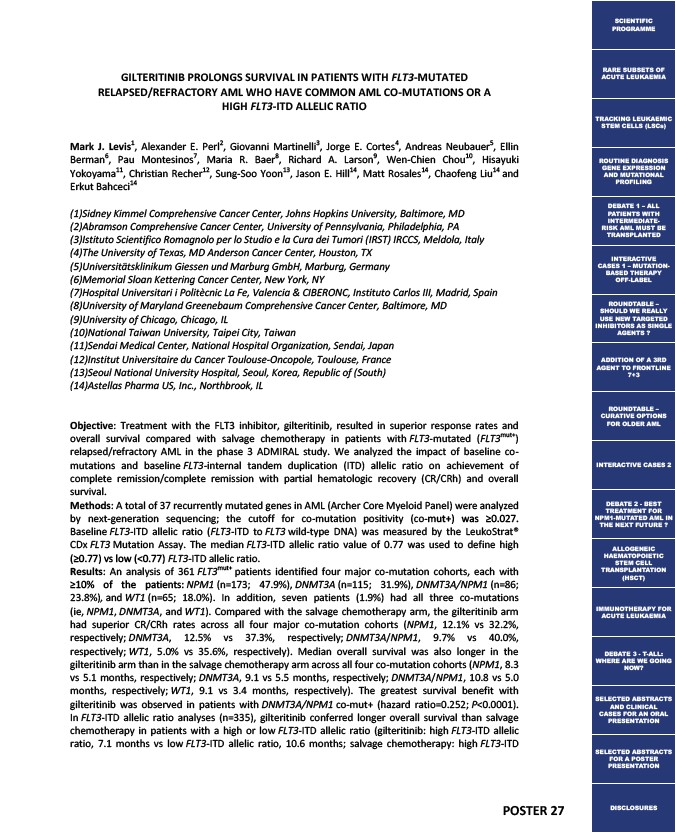
POSTER 27
GILTERITINIB PROLONGS SURVIVAL IN PATIENTS WITH FLT3-MUTATED
RELAPSED/REFRACTORY AML WHO HAVE COMMON AML CO-MUTATIONS OR A
HIGH FLT3-ITD ALLELIC RATIO
Mark J. Levis1, Alexander E. Perl2, Giovanni Martinelli3, Jorge E. Cortes4, Andreas Neubauer5, Ellin
Berman6, Pau Montesinos7, Maria R. Baer8, Richard A. Larson9, Wen-Chien Chou10, Hisayuki
Yokoyama11, Christian Recher12, Sung-Soo Yoon13, Jason E. Hill14, Matt Rosales14, Chaofeng Liu14 and
Erkut Bahceci14
(1)Sidney Kimmel Comprehensive Cancer Center, Johns Hopkins University, Baltimore, MD
(2)Abramson Comprehensive Cancer Center, University of Pennsylvania, Philadelphia, PA
(3)Istituto Scientifico Romagnolo per lo Studio e la Cura dei Tumori (IRST) IRCCS, Meldola, Italy
(4)The University of Texas, MD Anderson Cancer Center, Houston, TX
(5)Universitätsklinikum Giessen und Marburg GmbH, Marburg, Germany
(6)Memorial Sloan Kettering Cancer Center, New York, NY
(7)Hospital Universitari i Politècnic La Fe, Valencia & CIBERONC, Instituto Carlos III, Madrid, Spain
(8)University of Maryland Greenebaum Comprehensive Cancer Center, Baltimore, MD
(9)University of Chicago, Chicago, IL
(10)National Taiwan University, Taipei City, Taiwan
(11)Sendai Medical Center, National Hospital Organization, Sendai, Japan
(12)Institut Universitaire du Cancer Toulouse-Oncopole, Toulouse, France
(13)Seoul National University Hospital, Seoul, Korea, Republic of (South)
(14)Astellas Pharma US, Inc., Northbrook, IL
Objective: Treatment with the FLT3 inhibitor, gilteritinib, resulted in superior response rates and
overall survival compared with salvage chemotherapy in patients with FLT3-mutated (FLT3mut+)
relapsed/refractory AML in the phase 3 ADMIRAL study. We analyzed the impact of baseline co-mutations
and baseline FLT3-internal tandem duplication (ITD) allelic ratio on achievement of
complete remission/complete remission with partial hematologic recovery (CR/CRh) and overall
survival.
Methods: A total of 37 recurrently mutated genes in AML (Archer Core Myeloid Panel) were analyzed
by next-generation sequencing; the cutoff for co-mutation positivity (co-mut+) was ≥0.027.
Baseline FLT3-ITD allelic ratio (FLT3-ITD to FLT3 wild-type DNA) was measured by the LeukoStrat®
CDx FLT3 Mutation Assay. The median FLT3-ITD allelic ratio value of 0.77 was used to define high
(≥0.77) vs low (<0.77) FLT3-ITD allelic ratio.
Results: An analysis of 361 FLT3mut+ patients identified four major co-mutation cohorts, each with
≥10% of the patients: NPM1 (n=173; 47.9%), DNMT3A (n=115; 31.9%), DNMT3A/NPM1 (n=86;
23.8%), and WT1 (n=65; 18.0%). In addition, seven patients (1.9%) had all three co-mutations
(ie, NPM1, DNMT3A, and WT1). Compared with the salvage chemotherapy arm, the gilteritinib arm
had superior CR/CRh rates across all four major co-mutation cohorts (NPM1, 12.1% vs 32.2%,
respectively; DNMT3A, 12.5% vs 37.3%, respectively; DNMT3A/NPM1, 9.7% vs 40.0%,
respectively; WT1, 5.0% vs 35.6%, respectively). Median overall survival was also longer in the
gilteritinib arm than in the salvage chemotherapy arm across all four co-mutation cohorts (NPM1, 8.3
vs 5.1 months, respectively; DNMT3A, 9.1 vs 5.5 months, respectively; DNMT3A/NPM1, 10.8 vs 5.0
months, respectively; WT1, 9.1 vs 3.4 months, respectively). The greatest survival benefit with
gilteritinib was observed in patients with DNMT3A/NPM1 co-mut+ (hazard ratio=0.252; P<0.0001).
In FLT3-ITD allelic ratio analyses (n=335), gilteritinib conferred longer overall survival than salvage
chemotherapy in patients with a high or low FLT3-ITD allelic ratio (gilteritinib: high FLT3-ITD allelic
ratio, 7.1 months vs low FLT3-ITD allelic ratio, 10.6 months; salvage chemotherapy: high FLT3-ITD
SCIENTIFIC
PROGRAMME
RARE SUBSETS OF
ACUTE LEUKAEMIA
TRACKING LEUKAEMIC
STEM CELLS (LSCs)
ROUTINE DIAGNOSIS
GENE EXPRESSION
AND MUTATIONAL
PROFILING
DEBATE 1 – ALL
PATIENTS WITH
INTERMEDIATE-RISK
AML MUST BE
TRANSPLANTED
INTERACTIVE
CASES 1 – MUTATION-BASED
THERAPY
OFF-LABEL
ROUNDTABLE –
SHOULD WE REALLY
USE NEW TARGETED
INHIBITORS AS SINGLE
AGENTS ?
ADDITION OF A 3RD
AGENT TO FRONTLINE
7+3
ROUNDTABLE –
CURATIVE OPTIONS
FOR OLDER AML
INTERACTIVE CASES 2
DEBATE 2 - BEST
TREATMENT FOR
NPM1-MUTATED AML IN
THE NEXT FUTURE ?
ALLOGENEIC
HAEMATOPOIETIC
STEM CELL
TRANSPLANTATION
(HSCT)
IMMUNOTHERAPY FOR
ACUTE LEUKAEMIA
DEBATE 3 - T-ALL:
WHERE ARE WE GOING
NOW?
SELECTED ABSTRACTS
AND CLINICAL
CASES FOR AN ORAL
PRESENTATION
SELECTED ABSTRACTS
FOR A POSTER
PRESENTATION
DISCLOSURES